Arriving in St Thomas a week before the event, we had not only time to practice on Flight Risk, the Nacra17 with local owner and good friend Teri McKenna, we watched the club prepare for their biggest event of the year. St Thomas Yacht Club is more of a sailing club than it’s name implies. Located on a lovely beach in Cowpit Bay, the beach cats are yards away from the club house. Kids can play in the trees or water while parents socialize, and everyone knows your name. It’s a friendly club and “No Shoes No Service” signs don’t exist.
El Gato first anchored, then moored across the 1 mile bay in Christmas Cove, a lovely anchorage complete with small reefs and loads of turtles. Waking up here to go race was a highlight, and it was only a 5 min dinghy ride that included dodging the occasional ferry boat wake.
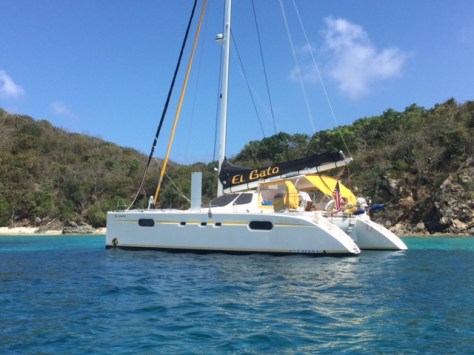
We watched the club ramp up by building stages for the bands, inflating the large buoys that were used in the ocean and bays, and building longer docks to accommodate the VX1’s that attended for the first time.
There were 8 classes competing. Gun Boats (large sexy multihulls built for cruising in style), CSA 1-4 (Caribbean Sailing Asociation), IC24’s (formerly J24’s but with scooped out decks), VX1’s, and the beach cats.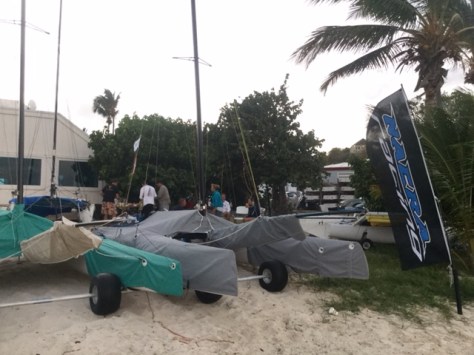
Last year 9 beach cats competed but this year the numbers were down. I’ve heard in the old days there were up to 30 cats when the Puerto Ricans would sail over and compete. It’s only 20-40 miles away so it must have been fun making that passage with others. Everyone loves the “Back in the day” stories, but some make us sad those days are over.
On Thursday, the tradition is to run the St John Round the Island Race. Since beach cats are not invited, and the wind was up, I accepted an invitation to race on Flow, a 60’ Gun Boat.
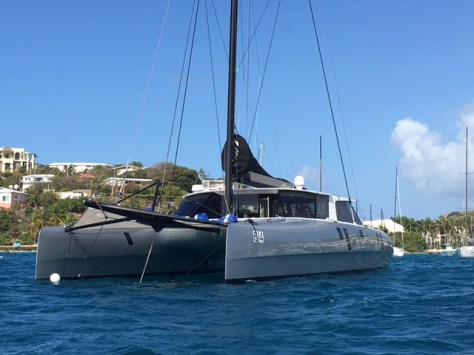 What a thrill to feel the power and speed, but even more thrilling was watching the crew work professionally to keep her moving safely in the right directions. Old friend and cat legend Cam Lewis was on board training Amy Drinker how to do pit which is located in front of the cabin house. In other words, when we crashed down on some big waves, these two were drenched! Sometimes waves would come flying through the cabin because the doors were open for the owner, Steve Cucchiaro, to see where he was going!
What a thrill to feel the power and speed, but even more thrilling was watching the crew work professionally to keep her moving safely in the right directions. Old friend and cat legend Cam Lewis was on board training Amy Drinker how to do pit which is located in front of the cabin house. In other words, when we crashed down on some big waves, these two were drenched! Sometimes waves would come flying through the cabin because the doors were open for the owner, Steve Cucchiaro, to see where he was going!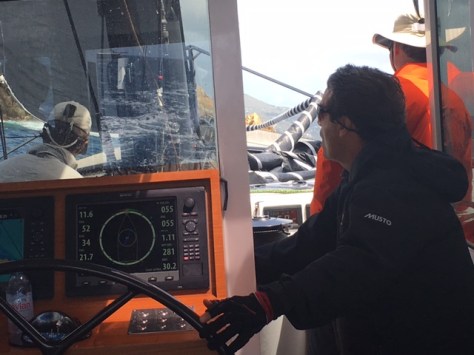
There are 2 wheels, one in front of the door, and one behind. Steve would choose which wheel depending how “fresh” things were outside. Closing the door means not hearing the folks up front. Not good. There were two strong guys doing bow with captain Tony floating around to help prevent anything seriously bad happening.
Another super cool feature was how the main was controlled. By a remote! Dru Slattery, who I met years ago in Dubai at an ISAF worlds, held this device in her hands and stared upwards from the back of the boat to control the hydraulics. That woman needed a neck massage afterwards!
 Inside the cabin was the brain trust. Larry Rosenfeld and Jeff Udell worked on navigation while Dru’s husband Jack managed the sail choices and trim. He and Dru own North Sails Marblehead.
Inside the cabin was the brain trust. Larry Rosenfeld and Jeff Udell worked on navigation while Dru’s husband Jack managed the sail choices and trim. He and Dru own North Sails Marblehead.
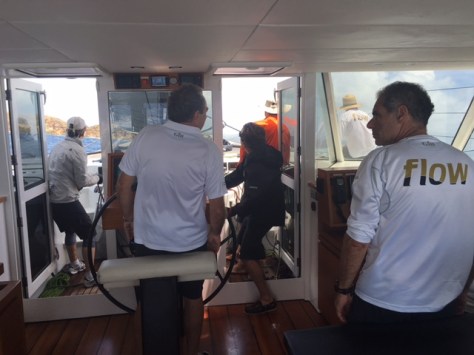
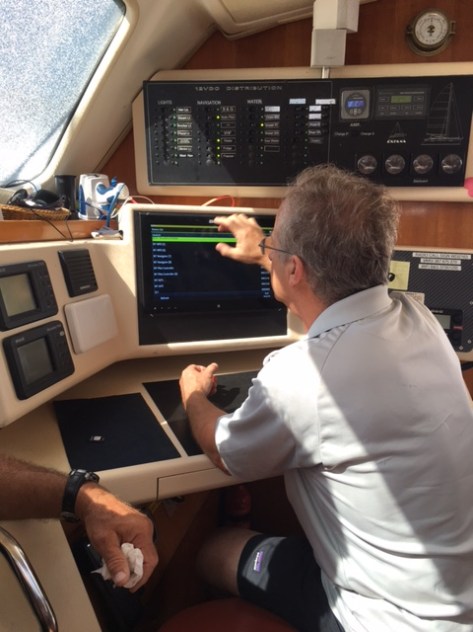
(this is actually inside El Gato but I wanted to add a photo of Jeff doing his B&G Genius work)
Karill, Tony’s first mate kept an eye on everyone and everything and Jama, Steve’s GF learned how to roll tack with me.
Roll tack you ask? In small mono hulls we roll from one side to the other and timed perfectly during a tack it propels the boat forward more than just changing sides. Roll tacking on a large multi hull means when you are up on the trampoline and the boat tacks, we roll our bodies across the trampoline and giggle while getting soaking wet! I learned this special maneuver watching one of the crews on the AC45’in the World Series and it was my first time too.
Maybe it will become a new trend…
Other than roll tacking I helped them identify marks and locations with my “local” knowledge, and mainly floated to help anyone who needed an extra hand.

On to racing in the STIR.
While Eric had been sick with flu after our kids left (someone brought the bug onboard after flying), by the time race day came Teri had the bug and Eric was well enough to sail. The three of us had all practiced in different combos and the original plan of Eric driving with Teri crewing was changed to me driving and Eric crewing. We were the defending champs so it was a winning combo, we just needed to get out there and do it again. The forecast all week had been for fresh to frightening and it was true. We started in about 20 knots, downwind, with two other beach cats. All others opted not to go. One Hobie 16, with a 16 year old skipper and a veteran crew, did great job of flying downwind, and we had a good neck and neck race towards the first mark. How could that be when we were on a faster design? We played it super conservative and sailed low and slow (which was still plenty fast) to stay onboard and finish the race in one piece. The boat and us. It worked. We sailed through waves and over waves and were constantly on our guard letting the spinnaker breath as needed. One capsize during a jibe and we were back up quickly. Crossing the finish line we were the first boat in the whole fleet. Sadly one of the beach cats lost control and capsized, turtled (upside down), got assistance when they couldn’t right it, and wound up not only losing the mast and sails, but also breaking both rudders and getting injured.
The boat was towed to shore on a small beach and still sits there while the owner recovers. At the awards ceremony the class presented the Wisdom award made up of parts of his boat including a green rudder piece. Wisdom for deciding Not to go out there!

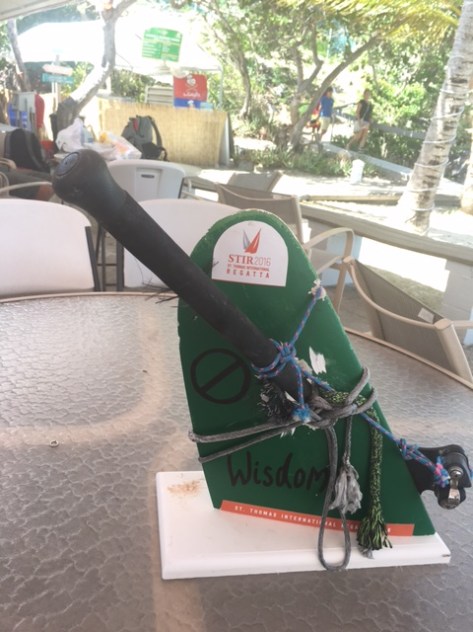
The second race was an upwind start and we had to circumnavigate Buck Island. By the time we rounded and were going back upwind we did not see the Hobie again. Turns out they got help and stopped at Buck Island. When Eric and I were heading to the finish line a squall came and it blew up to 30 knots. Grateful only 2 races!
The forecast did not ease up and when all beach cats declared not leaving the beach on day 2, I jumped back onboard Flow for another wonderful wild ride! They had not finished either race on Day 1 after their sail broke so they needed to win all races to win the regatta. So they did!
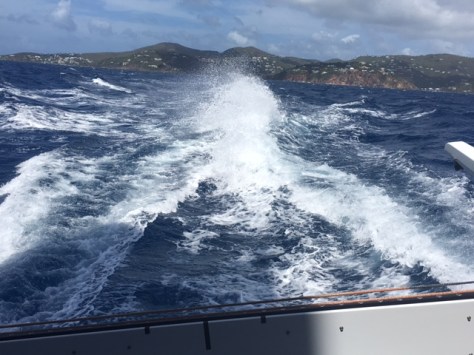
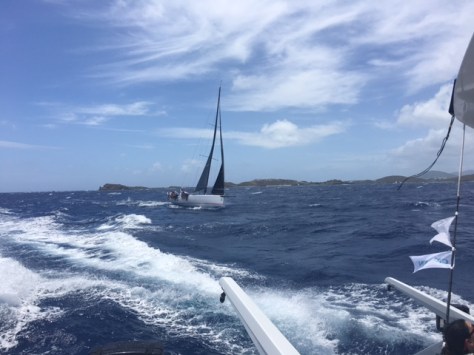
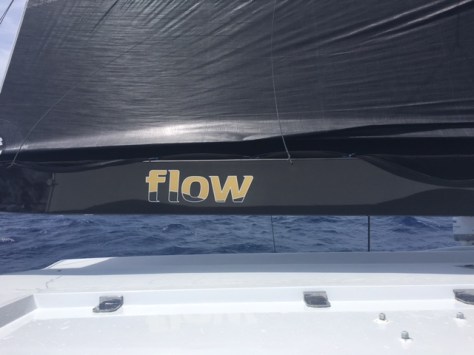
With the wind never letting up, the beach cats stayed ashore Saturday and Sunday. Two races constitute a series, so our two first place finishes sealed the deal. We would have preferred more racing for that beautiful watch that Eric now owns, but safety is always the most important aspect of sailing or racing, and we chose to not hurt us or the boat.
After racing on Flow and Flight Risk, going back to El Gato was like having the perfect trifecta. My love for catamarans has been with me since I was 15 years old and flying my first hull.
As the cats change, and it becomes more commonplace to see multi hulls racing and cruising, I am grateful for the good old days, the now days, and the knowledge that someday these days will be my good old days.
Writing will help me remember them better. And I look forward to sitting with grandkids telling them stories that might begin with something like “Did I ever tell you the story about the time we were sailing over big waves on a little cat and Grandma and Grandpa were winning a big race when all of a sudden the boat tipped over, crashed! And we had to jump in the water from up high in the sky?” “Or the time we saw pilot whales and turned around to sail next to them?”







Hi,
How exciting.
Thanks,
G.
LikeLike
Congrats Annie and Eric in winning the series. Being a watch nut what kind of watch did Eric win? Animal
LikeLike
It was I believe a locally made watch called Cardow. Have you heard of it?
Big and beautiful but not a Rolex. Or a Tag. They need more big boats to enter to get those back.
annie
LikeLike
I had not heard of the watch so I did some research and found their web site there wasn’t much technical information about their watches. I emailed them and they told that all the watches on the web site were quartz movements I thought as much looking at the prices of the watches . They purchase all their movements from Japan and Switzerland and assemble them in St. Tomas.They had a couple automatics and no manual wound movements but that were not on the web site . They had no specifications listed about their watches, i.e. Size,accuracy, diving depth but in the email they said a depth of 50 meters. In summary I think the watches are more of a novelty rather than an accurate time piece. I wonder if you tried to use your watch to find north and have you been practicing with your sextant.
PS. Nice nav. station on El Gratop
LikeLike